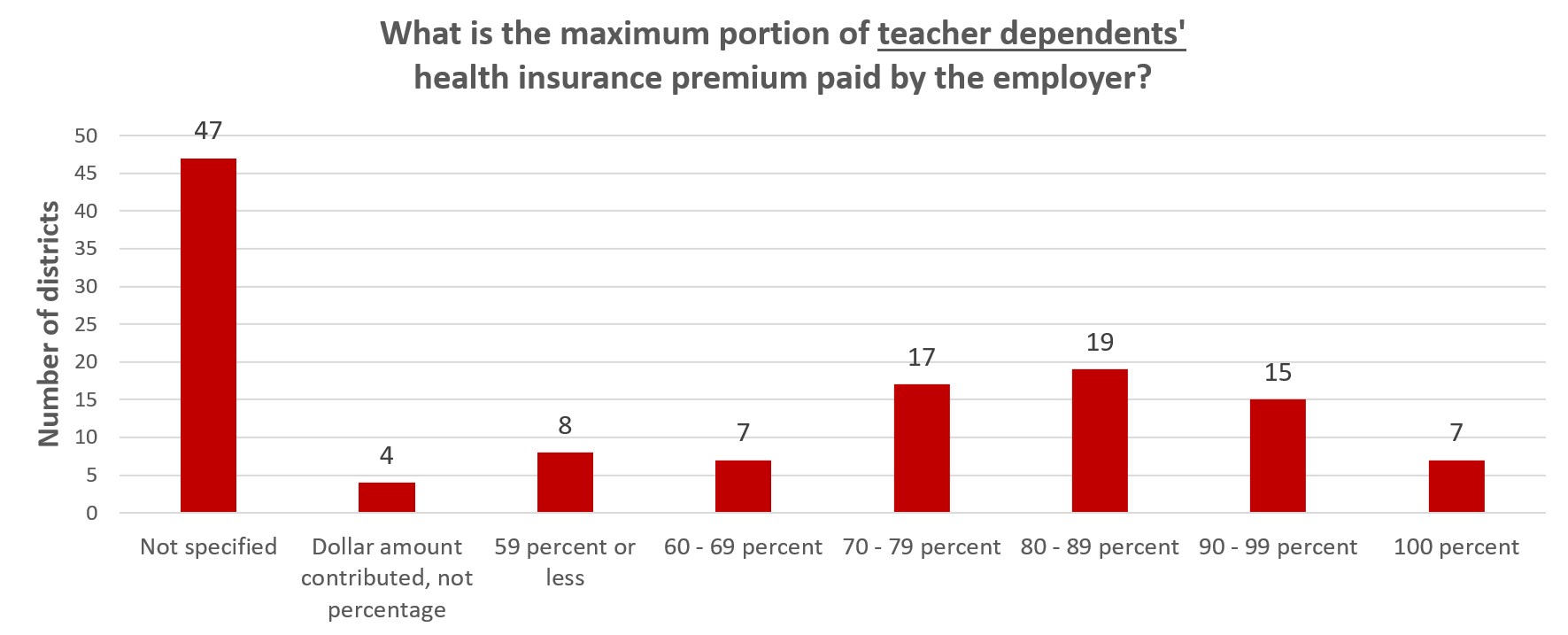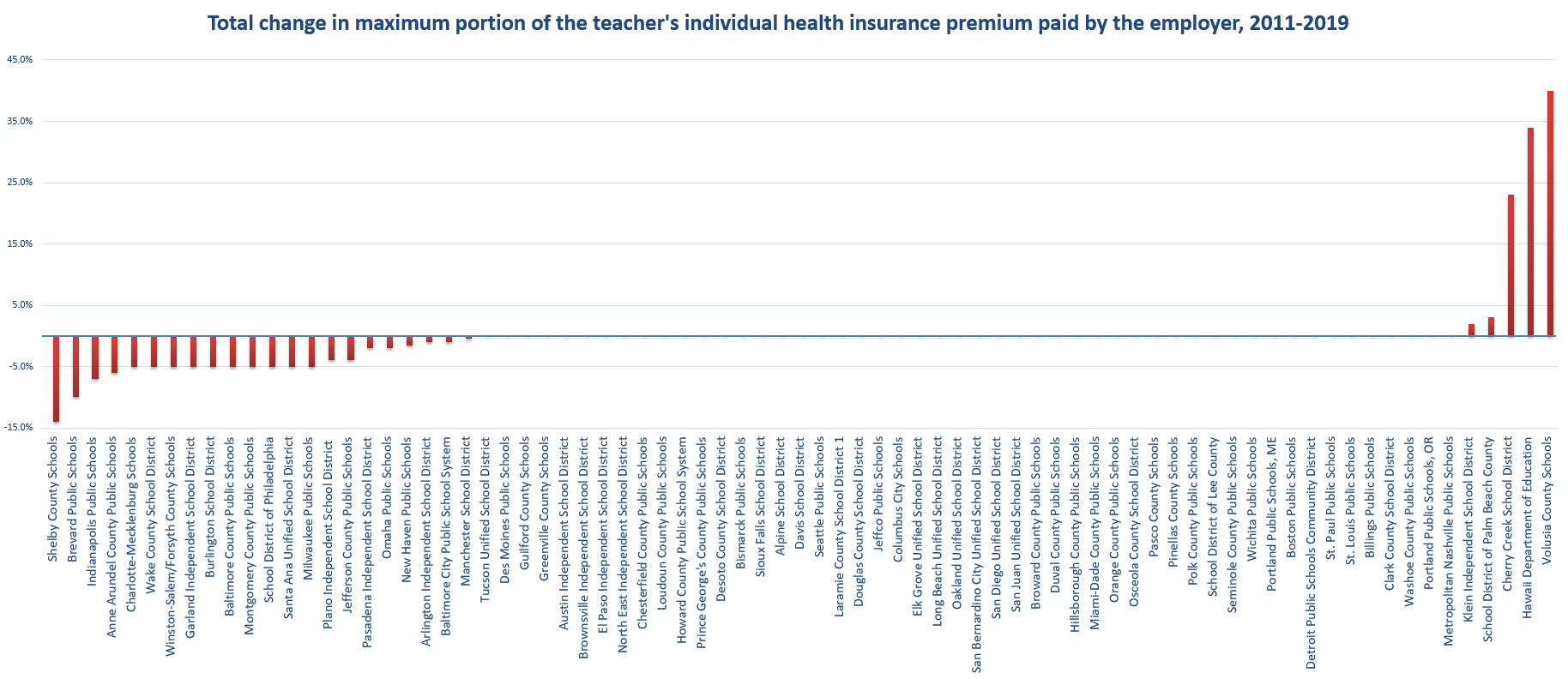The rising costs of health insurance have played a big role behind the scenes of teacher protests over the past year, taking up an ever greater share of the funds districts are able to dedicate to teacher compensation and leaving little room for raises. Health insurance premiums have exploded over the past 20 years, with healthcare provided to public school teachers serving as no exception to this trend.
One question is how districts are handling these increased costs. There is a common perception that school districts tend to pay nearly the full cost of a teacher's premium, even including dependents. Over the past decade, however, this has not been the case.
The NCTQ Teacher Contract Database tracks the portion of health insurance premiums that traditional public school districts cover for both teachers and their dependents in the largest 100 districts in the country as well as the largest district in each state. Combined these districts employ over 800,000 teachers.
What portion of teachers' individual health insurance premiums do districts cover?
There are 86 school districts in our database that specify the portion of the teacher's individual premium that the district covers. The portion of the teacher's premium that these large school districts cover on average is 92 percent. There are still 34 districts (40 percent) that cover 100 percent of the teacher's individual premium.
Teaching still looks better than other professions. Bureau of Labor Statistics (BLS) 2018 data show that private employers cover on average 79 percent of their employees' individual health premiums, about 13 percent lower than for teachers in these large districts.
What portion of teacher dependents' health insurance premiums do districts cover?
A 2013 analysis of BLS data found that teachers pay a larger portion of the health insurance premiums for family coverage than do private-sector professionals with employer-provided health care. That was a surprising finding, given that most people assume that public sector health care is generally more generous. Using 2018 data, we find no supporting evidence for that finding, although we are only looking at a relatively small subsample of districts. The average portion of private sector employee dependents' premiums covered by employers is 67 percent, while in the 73 districts that specify the portion of the teacher dependents' premiums they cover, the average is 79 percent.
There are still seven school districts in our sample where the employer covers 100 percent of the premium for teacher dependents: Alpine School District (UT), Bismarck Public Schools (ND), Des Moines Public Schools (IA), Long Beach Unified School District (CA), San Bernardino City Unified School District (CA), San Diego Unified School District (CA), and Wichita Public Schools (KS).
How is the coverage of health insurance premiums changing over time?
While premiums for all individual (public and private) employees have increased by an estimated 27 percent since 2011, the portion of these premiums paid by employers has remained surprisingly consistent. While this is the case for the majority of districts for which we have data, some large school districts are decreasing the portion of a teacher's individual premium they cover.
- Approximately two thirds of the districts have made no changes to the portion of the premium they pay for (50/77).
- Most of the remaining third have decreased their share by an average of 5 percent (22/77). Only eight of these 22 districts collectively bargain health insurance.
- Notably there are five districts (four of which collectively bargain health insurance coverage) that increased their portion of the premium.
Three of those five districts made particularly large jumps in what they pay toward their teachers' premiums. Cherry Creek School District (CO) had only covered 38 percent of a teacher's individual premium as of 2016, but now covers 61 percent. In 2012, the Hawaii Department of Education covered only 50 percent of the premium, but now covers 84 percent, and Volusia County Schools (FL) increased their coverage from 60 percent in 2016 to 100 percent in the current school year.
It should be noted that our data do not include the quality of the plans school districts offer, so we cannot track if there have been changes in quality of coverage.
Are rising health insurance costs cutting into teacher salaries?
The scheduled salary for a mid-career teacher (a teacher with an MA and 10 years of experience) has increased by an average of 11 percent in the districts NCTQ tracks since 2011—not keeping up with inflation which stands at 15 percent over that period.
Using a sample of those large districts for which we have both change in salary and change in health insurance premium coverage since 2011 (n=37), we found that those districts where the portion of the premium covered by the employer decreased saw a 14 percent increase in mid-career teacher salaries. Those districts that maintained or increased their portion of the premium saw mid-career teacher salaries increase an average of 10 percent. These limited findings are consistent with the idea that school districts are facing a trade-off between salary increases and health benefits.



